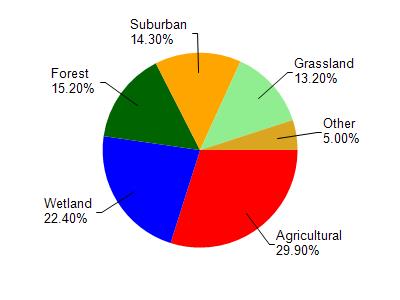Waukesha
No
No
No
Fish and Aquatic Life
Overview
Rock River Water Quality Management Plan, Lower Rock River Appendix. WT-668-2002. South Central Region, WDNR.
Scuppernong Creek, a major tributary to the Bark River, rises at the edge of the moraines in central Waukesha County. The creek passes through rural areas much of its length, but subdivisions are developing rapidly in the upstream reach near Wales. Numerous drainage ditch inlets carry agricultural runoff to the stream. There are two impoundments on Scuppernong Creek. Historical records suggest the reach from the headwaters to Waterville Lake supported a viable trout population in the early part of this century. Excessive ditching of tributaries and wetlands and the construction of a dam at Waterville, altered stream habitat so it now supports a warm water sport fishery. From the Waterville dam downstream to Dutchman Lake the stream supports a Class I trout fishery due to a large spring that augments flow and lowers stream temperature. Water quality from Dutchman Lake to the old Dousman Millpond is good. There are many springs and the reach supports a warm water sport fishery. Below the Dousman Millpond water quality is poor due to the large sediment load and a much lower gradient.
Date 2002
Author Aquatic Biologist
Condition
Wisconsin has over 84,000 miles of streams, 15,000 lakes and milllions of acres of wetlands. Assessing the condition of this vast amount of water is challenging. The state's water monitoring program uses a media-based, cross-program approach to analyze water condition. An updated monitoring strategy (2015-2020) is now available. Compliance with Clean Water Act fishable, swimmable standards are located in the Executive Summary of Water Condition in 2018. See also the 'monitoring and projects' tab.
Reports
Management Goals
Wisconsin's Water Quality Standards provide qualitative and quantitative goals for waters that are protective of Fishable, Swimmable conditions [Learn more]. Waters that do not meet water quality standards are considered impaired and restoration actions are planned and carried out until the water is once again fishable and swimmable
Management goals can include creation or implementation of a Total Maximum Daily Load analysis, a Nine Key Element Plan, or other restoration work, education and outreach and more. If specific recommendations exist for this water, they will be displayed below online.
Monitoring
Monitoring the condition of a river, stream, or lake includes gathering physical, chemical, biological, and habitat data. Comprehensive studies often gather all these parameters in great detail, while lighter assessment events will involve sampling physical, chemical and biological data such as macroinvertebrates. Aquatic macroinvertebrates and fish communities integrate watershed or catchment condition, providing great insight into overall ecosystem health. Chemical and habitat parameters tell researchers more about human induced problems including contaminated runoff, point source dischargers, or habitat issues that foster or limit the potential of aquatic communities to thrive in a given area. Wisconsin's Water Monitoring Strategy was recenty updated.
Grants and Management Projects
Monitoring Projects
| WBIC | Official Waterbody Name | Station ID | Station Name | Earliest Fieldwork Date | Latest Fieldwork Date | View Station | View Data |
|---|
| 825600 | Scuppernong Creek | 10029546 | Scuppernong Cr at the footbridge on the Lapham Peak Tr | 6/24/2003 | 9/26/2025 | Map | Data |
| 825600 | Scuppernong Creek | 683087 | Scuppernong Creek at Sth 18 Upstm | | | Map | Data |
| 825600 | Scuppernong Creek | 10009263 | Scuppernong Creek 1 Upstream Of Cth C | 10/29/2002 | 10/29/2002 | Map | Data |
| 825600 | Scuppernong Creek | 10040603 | Scuppernong Creek at STH 18 | 6/24/2003 | 6/24/2018 | Map | Data |
| 825600 | Scuppernong Creek | 10029547 | Scuppernong Cr US of pool on Private Prop near Lapham Peak Tr | 1/1/2015 | 1/1/2015 | Map | Data |
|

Watershed Characteristics
Scuppernong Creek is located in the Bark River watershed which is 185.84 mi². Land use in the watershed is primarily agricultural (29.90%), wetland (22.40%) and a mix of forest (15.20%) and other uses (32.50%). This watershed has 265.69 stream miles, 3,499.26 lake acres and 22,145.94 wetland acres.
Nonpoint Source Characteristics
This watershed is ranked Medium for runoff impacts on streams, High for runoff impacts on lakes and High for runoff impacts on groundwater and therefore has an overall rank of High. This value can be used in ranking the watershed or individual waterbodies for grant funding under state and county programs.However, all waters are affected by diffuse pollutant sources regardless of initial water quality. Applications for specific runoff projects under state or county grant programs may be pursued. For more information, go to surface water program grants.